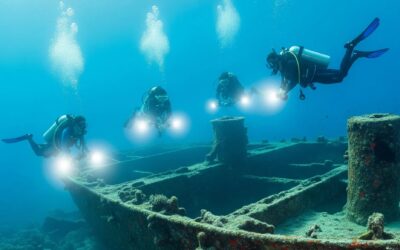Should I buy a BCD or a Wing?
No matter if novice or experienced divers, often divers are wondering weather to buy a BCD or a Wing. The answer often varies, depending on who is replying. We compare the options, highlighting advantages & disadvantages, to help you make a good choice. Ready for some new dive gear?
BCD vs. Wing:
Choosing the right buoyancy compensator (BC) is a critical decision for scuba divers, whether you are just starting out or have logged hundreds of dives. Your BC not only affects your comfort and safety underwater but also plays a vital role in your overall diving experience. The two most popular types of BCs are the traditional jacket-style BCD and the wing-style BC, commonly known as a “wing.” This article will compare these two options, highlighting their advantages and disadvantages, to help you make an informed choice. Ultimately, we’ll recommend why even novice divers should consider making the switch to a wing.
What is a Traditional BCD?
A traditional BCD, often referred to as a jacket-style or vest-style BCD, is a piece of dive gear that wraps around the diver’s torso. It features pockets, adjustable buckets and often integrated weight pockets and a few D-rings for attaching accessories. The BCDs air bladder inflates around the diver’s sides and back.
Advantages of Traditional BCDs
- Comfortable and Familiar: The jacket-style BCD is often favoured by new divers because it feels similar to wearing a vest. The comfort and familiarity make it a popular choice for beginners. It often provides a secure feeling both at the surface and underwater.
- Integrated Weight System: Many traditional BCDs come with integrated weight pockets, allowing divers to eliminate the need for a separate weight belt. This makes it easier to adjust buoyancy and can be more comfortable than a belt, especially when needing a higher amount of led.
- Pockets and D-rings: With various pockets and D-rings, divers can carry numerous accessories, tools, and gadgets easily, making it convenient to store items needed for the dive.
Disadvantages of Traditional BCDs
- Bulk and Drag: Traditional BCDs are often bulkier than wings. The wraparound design can create additional drag underwater, which can lead to more effort and air consumption, reducing the efficiency of a dive.
- Impaired Trim and Buoyancy Control: Because the air bladder inflates around the sides as well as the back, it can sometimes cause a diver to float upright at the surface or tilt to one side. This can make achieving a streamlined horizontal position (trim) more difficult, which is less ideal for buoyancy control.
- Less Streamlined Design: The design of traditional BCDs can make it challenging to achieve a streamlined profile underwater. Extra drag means more energy is needed to move, which can lead to quicker fatigue and higher air consumption.
- Limited Adjustability: Traditional BCDs come in fixed sizes, which may not fit every body type perfectly. A poorly fitting BCD can be uncomfortable and may affect buoyancy control and safety.
What is a Wing?
A wing-style BC consists of three main components:
1: The Wing is a donut-shaped or horseshoe-shaped bladder. Nowadays wings are available in many different sizes, shapes, designs and colours.
2: The Backplate is the central plate supporting the mounted tank, used provide stability and weight distribution. Backplates exist in different materials (e.g., aluminium, steel, carbon) as well as in different shapes and sizes.
3: The Harness is the mounting system holding the equipment in place whilst serving as support for securing accessories (e.g., SPG, light, stages etc). Many harnesses are basic webbing with fixed or flexible d-rings. However, harnesses exists also completely adjustable to your size, with extra comfort pads & pillows, additional clips and pockets, integrated weight systems etc.
Advantages of Wings
- Streamlined Design: The wing-style BC’s bladder sits entirely on the back, reducing drag and allowing for a more streamlined, efficient profile. Therefore, this minimizes resistance when moving through the water, making dives less tiring and more enjoyable. Due to the extra weight of the backplate, divers often need less led. Certainly, the combination of its design and needing less led give the diver the sensation of feeling “free” underwater.
- Better Trim and Buoyancy Control: Comparatively the wing promotes a horizontal swimming position, which is ideal for efficient movement underwater. Since the buoyancy is all in the back, it naturally encourages a flat, head-down posture, which helps divers maintain better trim and buoyancy control.
- Modular System: Furthermore, the modular nature of wings allows divers to customize and adjust their setup according to their specific needs. Components like the harness, wing, and backplate can be individually chosen and replaced. Consequently, the system offers greater flexibility than traditional BCDs. Finally the setup can be also easily adjusted for technical diving.
- Durability and Reliability: Wing-style BCs are often built to withstand rigorous diving conditions, making them a popular choice among professional and technical divers. Evidently the modular design also means that if one part of the system fails, it can be replaced without needing to buy an entirely new BCD.
- Improved Surface Comfort: With the buoyancy behind them, divers find it easier to maintain a face-up position at the surface without having to fight against the BCD. This makes surface swims more comfortable and less fatiguing.
Disadvantages of Wings
- Learning Curve: At first the concept of a wing might be unfamiliar and even an intimidating thought. The need to adjust the harness and understand the modular system can seem complex compared to the straightforward design of a traditional BCD.
- Less Pocket Space: Wings typically lack the built-in pockets found in traditional BCDs. Divers who rely heavily on carrying accessories may need to find alternative solutions, such as adding a thigh pocket or carrying a pouch, or clipping items to the d-rings (keep it streamlined!).
- Weight Management: Wing BCDs don’t always come with integrated weight systems and additional weight or trim pockets might be needed. However, as the set up is usually heavier than a normal BCD, divers usually need less led when diving in a wing.
Why Wings are Recommended Even for Novice Divers
While traditional BCDs offer a familiar, user-friendly experience for beginners, the benefits of wing-style BCs far outweigh their drawbacks, even for novice divers. Here’s why:
-> Better Trim and Buoyancy from the Start: Developing good buoyancy control is a crucial skill for all divers, and using a wing helps install this from the beginning. The streamlined design encourages a horizontal swimming position. Especially as a new diver it helps you to achieve better control and efficiency underwater.
-> Comfort and Reduced Fatigue: By reducing drag and providing a more balanced distribution of buoyancy, you will find swimming in a wing easier and less tiring. This is particularly beneficial for novice divers who may still be developing their strength and stamina underwater.
-> Long-Term Investment: Buying a wing is a long-term investment that grows with your experience level. The modular design means components can be replaced or upgraded individually. Consequently it makes it a versatile choice that can adapt to your growing experience and needs.
-> Adaptability for Different Dive Types: As you gain more experience, you may wish to explore different types of diving. Also depending on your needs you can add up (weight) pockets or enjoy the freedom around the chest and waist whilst only carrying the most necessary items. Wings are highly adaptable and can easily be modified for different environments and needs, making them a versatile option from the start.
-> Increased Safety: The better trim and buoyancy control provided by wing can lead to safer dives. By reducing the risk of rapid ascents or descents and improving the your ability to maneuver, wings enhance overall safety.
Therefore…
By choosing a wing, you invest in equipment that enhances your diving skills and grows with you, making every dive safer, more efficient, and more enjoyable. Independently your experience level, a wing is a worthwhile consideration that can transform your diving experience for the better. Nowadays most fabricants offer a huge choice of different pre-build package deals that already arrive fully set up. At first it might feel new and different to dive in a wing. However, after just a few dives you will enjoy the flexibility and freedom, never wanting to go back to a BCD. Wings are gaining steadily more popularity. Due its advantages some dive centers are expanding or even switching their offer of rental equipment.
As always, the market is free and the variety is big. However, our favourite brands to work with as professionals and for rental wings, are TecLine and Halcyon. Would like to try a wing during your next dive with us in Lanzarote? Contact us and reserve your wing for an unforgettable adventure.



